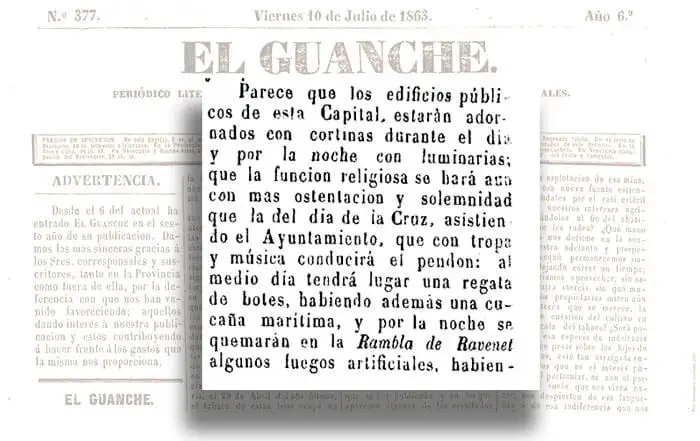Fuerteventura beaches, What to see in Fuerteventura ?
The Canary Latin Sailing (Vela latina)
If you search in the RAE (Royal Spanish Academy) the meaning of “Vela latina” will return the following result:
“Triangular sail, spanned in entena, which is usually used by small boats”.
Take advantage of a unique experience...
However, those two words (Vela Latina) in the Canary Islands have a deeper meaning. They are synonymous with tradition, sport, camaraderie and rivalry. It also takes us to a not too distant past, a time when sailing required personal effort and knowledge of ocean currents. Also of the winds so characteristic of the island.
The “small size” boats that the RAE tells us about, in the Canary Islands are called boats and barquillos
A bit of history about lateen sailing in the Canary Islands

The Castilian and Franco-Norman conquest of the Canary Islands brought with it a social, political, and economic culture that totally changed the lives of its inhabitants. Navigation was the determining factor, which drove the development of the archipelago to the level we are today.
Since the 15th century, large ships loaded with merchandise flocked to our shores. The handicap with which the tall ships were found was that they had a quite large draft (measured from the waterline). This made it impossible for them to approach the pier. Small boats with a single lateen sail were used to move both cargo and passengers from ships to shore, and vice versa.

These boats were light, fast and versatile. In addition, thanks to the constant winds that blow near the coast, sailing boats were the most suitable. They saved time and effort compared to rowing boats.
The small boats with lateen sail were not only used for coasting tasks, but they also adapted very well to the capricious changes that the wind makes along the coast. These characteristics made them ideal for inshore fishing.
Lateen sail boats played a fundamental role in the development of the towns. The terrestrial communications between the localities that were emerging along Fuerteventura, were very deficient. For this reason, on many occasions, the transfer of goods, and even people, had to be carried out by sea, using small cabotage boats.
The arrival of the industrial revolution, together with the development of large port infrastructures at the end of the 19th century, generated a strong demand for smaller vessels, usually used for loading and unloading goods, as well as for the transport of passengers. The situation increased the competition among the boatmen to see who was more comfortable and faster. The disputes were called “pegas”, slang that is still used today.
This rivalry was what gave rise to Latin Sailing as a sport.

Canarian Latin Sailing as a sport Latin sailing as an indigenous sport takes place on a regatta field, around which a variable number of boats will have to circle. Depending on the size of the race course, there will be more or less laps.
The winner of the regatta will be the one who reaches the finish line first, or the one with the best time.
The first documented regatta that we have found dates from 1863. It took place in Santa Cruz de Tenerife, during the Santiago Apóstol festivities.
The newspaper “El Guanche” thus reflected part of the program of the festivities:

At noon there will be a boat regatta, also having a maritime cucaña.
From then on, many coastal towns, both in Tenerife and Gran Canaria, had their regatta of smaller sailing boats.
Despite having passed more than a century and a half since the first regattas of wooden boats, their traditional way of sailing is still maintained, from south to north, against the wind, upwind or bowline (at an angle of 45 degrees in relation to with the wind direction).
Observing the development of a Latin sailing regatta is a different experience. To contemplate how the skipper of the boat uses the experience at sea, to anticipate the movements of their rivals, is simply exciting.
The Latin sailing season depends on the trade winds. Remember that between April and November the trade winds blow stronger in Fuerteventura. And that these fresh and constant Atlantic winds are responsible for maintaining a mild temperature, removing the suffocating heat of summer from our lands.

Although the measurements of the Latin sailing boats are highly variable: from 2.5 to 10 meters in length by 1 to 2 meters in beam, two modalities are used for the Latin Canary Sailing regattas: boats and barquillos.
The boats have a greater length. They measure 8.55 meters from bow to stern, while their beam (width) is 2.51 meters. The minimum crew to participate in a regatta with this type of boat is 8 and the maximum is 12.
In the 80s of the last century, in Lanzarote, Latin sailing regattas began with smaller boats, called barquillos. The barquillos have a length of 5 meters, a beam of 2 meters and the minimum crew to control them is 3, with 4 people being the maximum allowed to participate in the regattas.
In 2022 Fuerteventura will have the fortune to become the host of the Canarian Championship of Barquillos de Vela Latina. Both in the capital’s waters, between Puerto del Rosario and Playa Blanca, as well as in the tourist town of Corralejo, various Latin Sailing regattas will take place, which we invite you to see.
Fuerteventura2 Fuerteventura1 Fuerteventura5 Fuerteventura6





